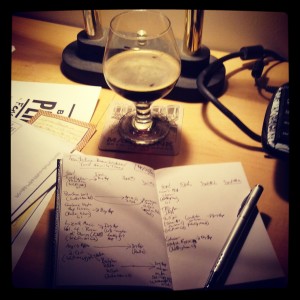I tend to be a little too ambitious when trying to schedule out my free time (read as, “I bite off more than I can chew”). My main goals for this past weekend were to smoke some beef jerky to break in my new smoker, and to brew a five gallon all-grain batch of a Pale Ale to break in my new outdoor brewing setup. The smoker day went off great and I ended up with a pound or so of two different types of pretty tasty jerky – not perfect, but that’s not what I was going for (what’s the fun if you don’t learn anything?). The brew day … well, it ended up not even happening on Sunday and ended up getting substituted for a smaller, brew-in-a-bag brew day on Monday night.
This slideshow requires JavaScript.
Jerky
I was able to marinate both types of jerky overnight, as planned. One pound got the steak sauce marinade, the other pound go a fairly traditional Cajun rub that was a bit heavier on the brown sugar. In the end, I ended up smoking the jerky (with charcoal as a base and soaked hickory chunks on top for smoke flavoring) for about four or so hours. Overall, both versions came out very tasty, although the Cajun probably edged out the steak sauce version as a favorite. We had a barbecue on Sunday with a few people and I had both versions out – the Cajun version got pretty well massacred, which I take as a pretty good compliment. However, I definitely learned a lot about my smoker, and making jerky in general, and plan on making a few improvements on the next go-around:
- I started with a heaping charcoal chimney of charcoal, as well as a healthy of water-soaked hickory chunks, when I started up the smoker. The smoker’s manual suggested 10-15 pounds of charcoal to start, which seemed very high to me, so I decided to go with about the same amount (probably a little more) than I would use in my Weber charcoal kettle grill if I’m cooking a lot of food for an hour or so. It ended up driving the temp on the smoker a bit higher than I wanted – it went up to around 300F*. I decided to go with it anyway, and let it free fall back down, which it did. I ended up needing to add another partial chimney towards the end to keep the temp up closer to 200F*, as well as some more hickory (mainly for flavor, not heat). Next time, I plan to dial back the starting amount to maybe three-quarters of a chimney, and lighting up more to add, as needed. I would rather have to add coals once or twice more during the cook to get that nice slow-and-low cooking process.
- When I got the meat this time, I ended up getting a little over two pounds of london broil and having the butcher cut it for me. Next time, I plan on either using a thicker top round roast, or cutting at an angle to get a wider swatch of meat. This batch came out more like sticks – which tasted great, but I tend to prefer a little wider strip to bite into.
- Next time I will try to aim for more chewiness. This batch came out great, but it probably could have used a little less time in the smoker. I think the initial hot start, sped up the cooking process a bit more than I like, especially with the narrower cut. Now, I have a little better grasp on what to look for in the jerky as it cooks.
*A note on smoker temp. If you have a backyard smoker, I do recommend getting a reliable oven thermometer to use with your smoker. Most smokers come with built-in thermometers. A lot of these thermometers are not very specific (mine has three zones – warm, ideal, and hot) or accurate. Pick up an inexpensive, but reliable dial oven thermometer.
Tire Kicker Pale Ale – The Express Version
I thought it would be a great idea to do an all-grain brew day on the same day as having a few people over for an afternoon/evening barbecue. And, to be fair, it probably would have been a great idea, had everything gone smoothly. Afterall, the brewing and barbecuing space is the same – the back patio. Not to mention the gorgeous weather the Philly area saw on Sunday. Too bad I couldn’t get my new burner to work right.
Don’t get me wrong – the blame mostly lies with me for not testing the burner out thoroughly enough ahead of time. My idea of testing out the burner was to hook it up to a tank on Sunday and make sure I could light it. What I did not do is make sure I could get a low, blue flame. Come Sunday morning, I was having all sorts of trouble heating my strike water because I was getting a ridiculously tall, yellow flame and it kept lighting at the damper where the air and propane mix. Not good. After messing with it for a couple of hours and getting very frustrated (remember, it had been three months since I brewed), I finally bagged the brew day and shifted gears to getting ready for people to come over. After talking over the issue with my buddy and my father-in-law at the BBQ, the consensus was that the burner probably had something obstructing the flow of gas and air coming into the vents causing it to not get hot enough, and to light by the damper.
Sure enough, after getting in there with a little wire on Monday night after work, I hooked up the tank again, lit it, and bingo – much more reasonable, blue flame. Must have been a little gunk or debris blocking the gas flow. Now that I was back in business, it was time to brew. I didn’t exactly have time to brew a full five gallon all-grain batch on a weeknight (“ain’t nobody got time for that”), and didn’t really feel like waiting until the weekend for the batch, which would set me back even further. So, cut the recipe in half, put the grain in the trusty ol’ mesh bag, and rock it brew-in-a-bag style. Still a great way to try out the new burner and kettle, and a good way to do a true BIAB brew day for the first time (I have done BIAB before to great success, but have always had to do a sparge with it because my biggest kettle was a five-gallon and I was brewing on an electric range). Same as the smoker break-in session, there were lessons to be had:
- My OG came out a little low (1.053) compared to the recipe calculations (1.061). Next time I do BIAB, I will probably over-compensate with a little extra base malt since I don’t have a mill of my own yet to dial it down to a finer crush.
- I definitely got a larger amount of boil loss and equipment loss than I anticipated. I ended up with about 2.25 gallons after adding in the yeast starter. The burner (once it was working right) was a work horse and the kettle had a little wider surface area than my old kettle so I ended up getting a larger boil off than I am used to, as well as more trub left in the kettle (not really a bad thing) at the end thanks to my bazooka screen inside my kettle. Next time, I will have to up the starting boil volume.
Overall, the beer should still come out damn tasty and is bubbling away in the carboy now. One of the main reasons I went with APA as a style for the first brew was that if I missed the OG in either direction, I would still have a very drinkable beer. I should end up with a hoppy 5-ish% pale.
All in all, the brew day served its purpose – I have beer in the carboy and I learned some lessons on the new equipment. Can’t wait to brew again and taste the pale ale when it gets the dry hops this weekend. I think I can now say that I am back in the damn saddle.
Tire Kicker Pale Ale (A Very Quick Game-Time Shift to BIAB)
Recipe specifics:
Style: American Pale Ale
Batch size: 2.5 gal
Boil volume: 3.5 gal
OG: 1.061
FG: 1.015
Bitterness (IBU): 42.2
Color (SRM): 6.0
ABV: 6.0%
Grain/Sugars:
5.00 lb Two-row (US), 90.9%
0.50 lb Crystal 20L, 9.1%
Hops:
0.50 oz Cascade (AA 6.6%, Whole) 60 min, 21.8 IBU
0.50 oz Cascade (AA 6.6%, Whole) 15 min, 10.8 IBU
1.00 oz Cascade (AA 6.6%, Pellet) 5 min, 9.6 IBU
1.00 oz Simcoe (AA 12.2%, Pellet) 0 min, 0.0 IBU
1.00 oz Centennial (AA 9.0%, Pellet) dry hop
Yeast/Misc:
California Ale yeast, 1.0 unit(s), Yeast
Irish Moss, 1.0 unit(s), Fining 1 tsp at 15 min
Song of the Day: “Somewhere in the Between” by Toh Kay
Beer of the Day: Iron Hill (Media)/Ithaca collaboration Dark Humor Rising aged in Sherry Barrels




